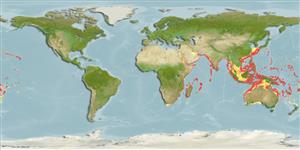Environment: milieu / climate zone / depth range / distribution range
Ecología
marino asociado a arrecife; rango de profundidad 1 - 650 m (Ref. 34024), usually 180 - 220 m (Ref. 37816). Tropical; 33°N - 38°S, 17°E - 155°W (Ref. 34024)
Indo-Pacific: Red Sea and East Africa to Pitcairn, north to southern Japan, south to Lord Howe Island. Also reported from Persian Gulf (Ref. 68964).
Tamaño / Peso / Age
Maturity: Lm ? range ? - ? cm
Max length : 100.0 cm TL macho / no sexado; (Ref. 5213); common length : 30.0 cm TL macho / no sexado; (Ref. 9987)
Short description
Claves de identificación | Morfología | Morfometría
Espinas dorsales (total) : 0; Radios blandos dorsales (total) : 109 - 139; Espinas anales: 0; Radios blandos anales: 80 - 106. In addition to meristic counts, B. multibarbata differs from B. townsendi by possessing a larger eye (width>interorbital space) and having slightly different coloration (dark brown with a submarginal black band and narrow white border on the dorsal and anal fins versus greenish to orange brown with orange-bordered dorsal and anal fins).
Benthopelagic on shelf and upper slope (Ref. 34024). Larvae found in the epipelagic far offshore (Ref. 34024). Found in shallow lagoon and seaward reefs and occurs at depths of at least 220 m. Adults (30-90 cm) move to depths of 100-650 m (Ref. 58472). A nocturnal species, rarely seen for it lives in caves and crevices during the day and periodically emerges from cover at night to feed on crustaceans, mainly crabs, and fishes. Oviparous, with oval pelagic eggs floating in a gelatinous mass (Ref. 205). Utilized fresh and eaten steamed, pan-fried and baked (Ref. 9987). Also Ref. 58302.
Life cycle and mating behavior
Maturities | Reproducción | Spawnings | Egg(s) | Fecundities | Larva
Nielsen, J.G., D.M. Cohen, D.F. Markle and C.R. Robins, 1999. Ophidiiform fishes of the world (Order Ophidiiformes). An annotated and illustrated catalogue of pearlfishes, cusk-eels, brotulas and other ophidiiform fishes known to date. FAO Fish. Synop. 125(18):178p. Rome: FAO. (Ref. 34024)
IUCN Red List Status (Ref. 130435)
Threat to humans
Harmless
Human uses
Pesquerías: escaso valor comercial; pesca deportiva: si
Herramientas
Special reports
Download XML
Fuentes de Internet
Estimates based on models
Preferred temperature (Ref.
123201): 13.4 - 23, mean 15.9 °C (based on 98 cells).
Phylogenetic diversity index (Ref.
82804): PD
50 = 0.5156 [Uniqueness, from 0.5 = low to 2.0 = high].
Bayesian length-weight: a=0.00380 (0.00154 - 0.00938), b=3.13 (2.91 - 3.35), in cm total length, based on LWR estimates for this (Sub)family-body shape (Ref.
93245).
Nivel trófico (Ref.
69278): 3.7 ±0.5 se; based on diet studies.
Resiliencia (Ref.
120179): Bajo, población duplicada en un tiempo mínimo de 4.5-14 años (Preliminary K or Fecundity.).
Fishing Vulnerability (Ref.
59153): High vulnerability (60 of 100).
Nutrients (Ref.
124155): Calcium = 25 [13, 44] mg/100g; Iron = 0.433 [0.251, 0.892] mg/100g; Protein = 17.1 [14.5, 19.6] %; Omega3 = 0.116 [0.064, 0.221] g/100g; Selenium = 79.6 [41.6, 152.0] μg/100g; VitaminA = 48.3 [16.9, 136.7] μg/100g; Zinc = 0.852 [0.592, 1.209] mg/100g (wet weight);
